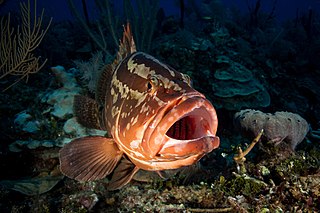
The Nassau grouper is one of the large number of perciform fishes in the family Serranidae commonly referred to as groupers. It is the most important of the groupers for commercial fishery in the West Indies, but has been endangered by overfishing.
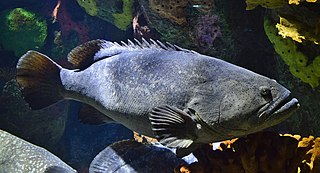
The giant grouper (Epinephelus lanceolatus), also known as the Queensland groper (grouper), brindle grouper or mottled-brown sea bass, is a species of marine ray-finned fish, a grouper from the subfamily Epinephelinae which is part of the family Serranidae, which also includes the anthias and sea basses. It has a wide Indo-Pacific distribution and is one of the largest extant species of bony fish.

The marbled parrotfish, also known as the seagrass parrotfish, is a species of marine ray-finned fish, a parrotfish from the family Scaridae and is the only known member of the genus Leptoscarus. It has a wide Indo-Pacific distribution and is also found in the southeastern Atlantic Ocean. It is a coastal species found in beds of sea grass and seaweed.
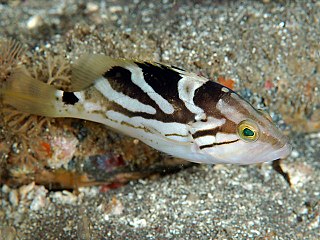
The comet grouper, also known as the comet cod or dot-dash grouper, is a species of marine ray-finned fish, a grouper from the subfamily Epinephelinae which is part of the family Serranidae, which also includes the anthias and sea basses. It is a species of deep coral reefs in the Indo-Pacific region.
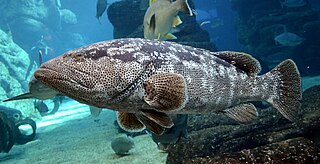
The Malabar grouper also known as blackspot rockcod, estuary rockcod, giant rock cod, greasy grouper, Malabar rockcod, Morgan's cod or speckled grouper, is a species of marine ray-finned fish, a grouper from the subfamily Epinephelinae which is part of the family Serranidae, which also includes the anthias and sea basses. It is found in the Indo-Pacific region. It has entered the Mediterranean Sea from the Red Sea by way of the Suez Canal as a Lessepsian migrant.

The Indo-Pacific sergeant is a species of damselfish in the family Pomacentridae. It may also be known as the Sergeant major although this name is usually reserved for the closely related species Abudefduf saxatilis. The closely related Abudefduf caudobimaculatus was formerly considered to be synonymous with this species and, according to some authorities, is synonymous.

The Hong Kong grouper is a species of marine ray-finned fish, a grouper from the subfamily Epinephelinae which is part of the family Serranidae, which also includes the anthias and sea basses. It is found in eastern and southeastern Asian waters of the Western Pacific Ocean. Its natural habitats are shallow seas and coral reefs.

The orange-spotted grouper, also known as the brown-spotted rockcod, estuary cod, estuary rockcod, goldspotted rockcod, greasy cod, North-west groper, orange spotted cod or blue-and-yellow grouper, is a species of marine ray-finned fish, a grouper from the subfamily Epinephelinae which is part of the family Serranidae, which also includes the anthias and sea basses. It has an Indo-Pacific distribution and is found in marine and brackish waters.
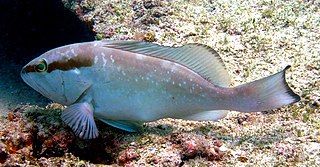
The red grouper is a species of marine ray-finned fish, a grouper from the subfamily Epinephelinae which is part of the family Serranidae, which also includes the anthias and sea basses. It is found in the western Atlantic Ocean.

The camouflage grouper, also known as the blue-tailed cod, camouflage rockcod, small-toothed rockcod, smooth flowery rock-cod, snout-spot grouper or snout-spot rock-cod, is a species of marine ray-finned fish, a grouper from the subfamily Epinephelinae which is part of the family Serranidae, which also includes the anthias and sea basses. It has a wide Indo-Pacific distribution where it is associated with reefs.

The Gulf grouper is a species of marine ray-finned fish, a grouper from the subfamily Epinephelinae which is part of the family Serranidae, which also includes the anthias and sea basses. It is endemic to Mexico.

The potato grouper, also called the potato cod or potato bass, is a species of marine ray-finned fish, a grouper from the subfamily Epinephelinae which is part of the family Serranidae, which also includes the anthias and sea basses. It has a wide Indo-Pacific distribution.

The honeycomb grouper, also known as black-spotted rock-cod, common birdwire rockcod, dwarf spotted rockcod, dwarf-spotted grouper, honeycomb cod, wire-netted reefcod or wire-netting cod, is a species of marine ray-finned fish, a grouper from the subfamily Epinephelinae which is part of the family Serranidae, which also includes the anthias and sea basses. It has a wide Indo-Pacific distribution where it is found in coastal and offshore reefs in shallow waters.
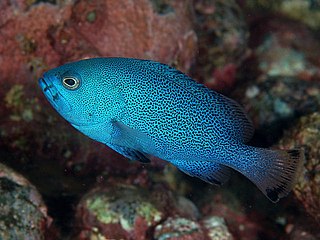
Epinephelus cyanopodus, the speckled blue grouper, also known as the blue maori, purple rock cod, speckled grouper or yellowfin grouper, is a species of marine ray-finned fish, a grouper from the subfamily Epinephelinae which is part of the family Serranidae, which also includes the anthias and sea basses. It is found in the Western Pacific Ocean where it occurs in corals.

Epinephelus ongus, the white-streaked grouper, specklefin grouper, lace-finned rock-cod, specklefin rockcod, wavy-lined tock-cod, white-speckled grouper or white-spotted rock-cod, is a species of marine ray-finned fish, a grouper from the subfamily Epinephelinae which is part of the family Serranidae, which also includes the anthias and sea basses. It has a wide Indo-Pacific distribution and it is found in brackish waters as well as marine reefs.

Epinephelus maculatus, the highfin grouper, blackfin cod or brown-spotted rock-cod, marbled rock-cod or spotted grouper, is a species of marine ray-finned fish, a grouper from the subfamily Epinephelinae which is part of the family Serranidae, which also includes the anthias and sea basses. It is found in the Indo-Pacific region.
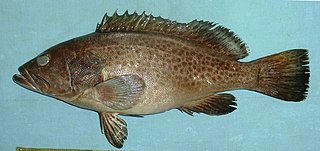
Epinephelus bleekeri, the duskytail grouper, Bleeker's grouper or Bleeker's rockcod, is a species of marine ray-finned fish, a grouper from the subfamily Epinephelinae which is part of the family Serranidae, which also includes the anthias and sea basses. It is found in the Indo-Pacific region where it is associated with shallow banks.
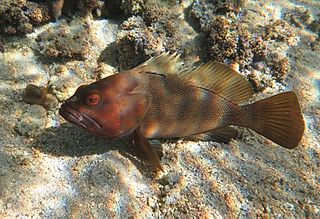
Epinephelus rivulatus, the halfmoon grouper, halfmoon rockcod, Chinaman rockcod, Charlie court cod, green-finned rock cod, or white-dotted grouper, is a species of marine ray-finned fish, a grouper from the subfamily Epinephelinae which is part of the family Serranidae, which also includes the anthias and sea basses. It is found in the Indo-Pacific region.

Dermatolepis dermatolepis, the leather bass is a species of marine ray-finned fish, a grouper from the subfamily Epinephelinae which is part of the family Serranidae, which also includes the anthias and sea basses. It is a predatory reef fish which is found in the eastern Pacific Ocean.
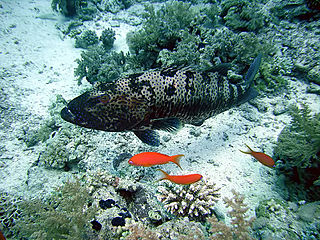
The squaretail coral grouper is a species of marine ray-finned fish. It is a grouper from the subfamily Epinephelinae, which is part of the family Serranidae. This family also includes anthias and sea basses. The squaretail coral grouper is also known as the spotted coral trout or the squaretail coral trout, and is fast-growing, short-lived, and early-maturing. However, due to the continued decrease in its population, it is now classified as vulnerable, as it continues to face threats from human activity.





















